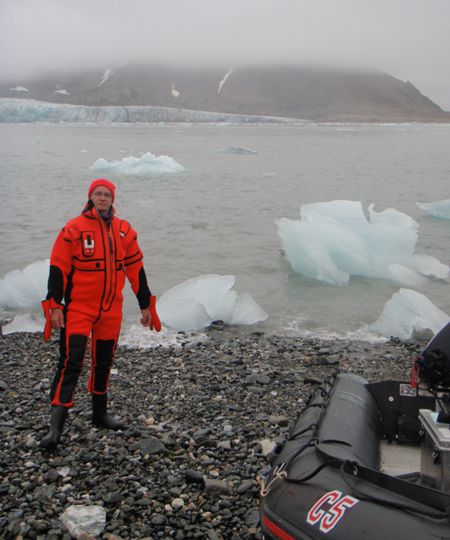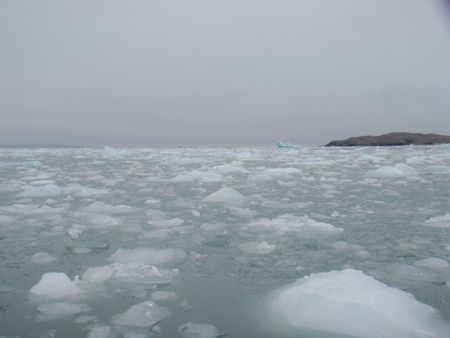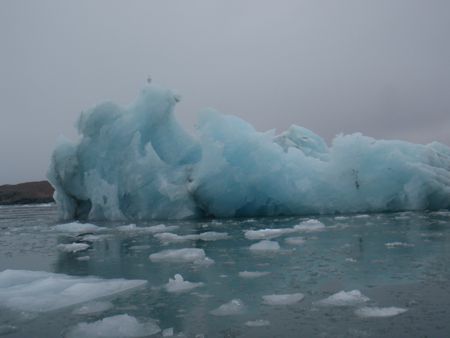7 am: The weather has cleared up and we can start field work again. According to Internet, we are in the sunshine. According to my own eyes, the clouds are still very low and all grey from one end of the horizon to the next. This morning, the beach was littered with small and big icebergs. Their clinking noise could be heard even from the base, 200 m away. After piling all the equipment in the boat, we are going back to Hans glacier, first to set up the stereo cameras on the hill overlooking it, second to get more underwater measurements. After the rain of the last days, the glacier has melted a bit more, and there is a lot of ice, including blue ice, everywhere around (blue ice is more compressed ice, coming from the base of the glacier).
9 am: Just as we approach the beach, a loud bang can be heard, and we turn back in time to see parts of the glacier falling off. We have seen that before, and it is always spectacular. As blocks of ice fall into the water, they create long waves, which do not seem that bad from our place. We use the first ones to help haul the boat onto the beach. And then the big one comes in … It looms large very quickly, bringing a 5-tonne iceberg too close for comfort … And then the gravel below my feet is pulled down, and I feel sucked into the water deeper than I expected … Luckily, the Arctic immersion suit is once again very useful …
I should have known: mini-tsunamis are a common risk near glaciers, and like other tsunamis, their height increases as they reach shallower water. Here in this fjord, the seabed is very steep, so the waves increase only very close to the shore. In other places in the Arctic, they can crash big icebergs onto structures or small harbours (when the places are settled).

10 am: The stereo cameras were easy to set up, with practice, and we will gather pictures every 5 seconds for the several hours to come. During this time, we’ll be drifting with the freshwater outflow from the glacier, measuring the noise underwater and finding ourselves in the middle of a very large and noisy ice flow.

Icebergs, icebergs everywhere … We have to push the pointiest ones away from the rubber tubes of our boat. Icebergs make clunking noises as they move below the aluminium hull, or big thumps when colliding with us (more or less gently).
11am : we get close to a very nice iceberg, made of blue ice and roughly 15 m large. Sea gulls use it as a vantage point, and it has already started to melt in a variety of interesting shapes. The seabirds turn around us with interest, before flying back to their resting place. We take the paddles out to move away (without too much noise: this would be bad for the measurements), and a few minutes later, this iceberg capsizes several times … Lucky escape …

1 pm: The rest of the measurements get by without excitement, as we get colder and colder despite our warm clothing. The walk up the hill to recover the cameras is a good way to warm up (I am on polar-bear watch and carry the rifle and emergency radio, fortunately not too heavy).
3 pm: Back to the shore. Someone is waiting for us to point at a relatively less dense group of icebergs. With Grant, we jump down in the water for the last few metres, moving the icebergs by hand away from the boat so that we can beach it safely. We are back in time for a good lunch, and can relax later to the sound of Mozart on an old vynil from the station’s collection, in the communal room. Then it will be back to work, downloading the data, checking the dozens of emails that accumulated at work back in our respective institutions, and preparing for tomorrow’s deployment. The network is slow again (kilobytes/second) and most connections do not work well … Typing letters. I see them on the screen 5-10 seconds later …
Midnight:: The autonomous recorder is now ready for tomorrow, and we cleaned our hands from the lubricant used to waterproof all the joints and connections. Time for more work: the rain outside looks suspiciously like sleet but I am not going to investigate. It’s warm and cosy inside.
Respond